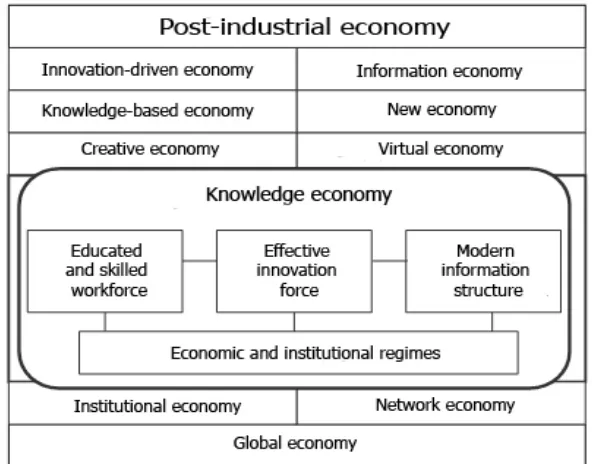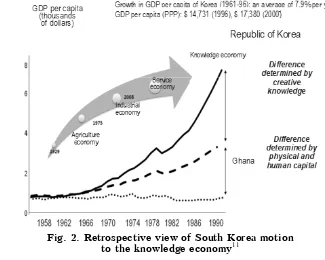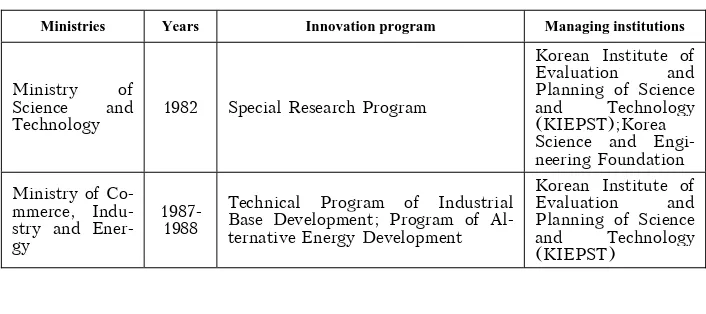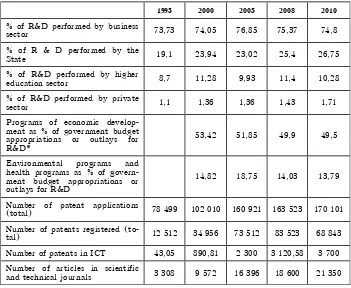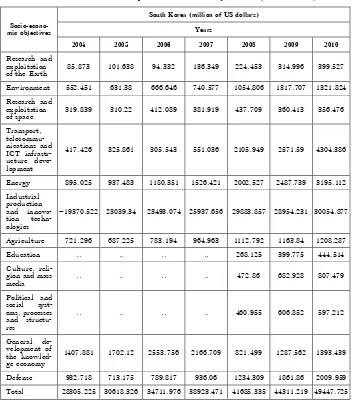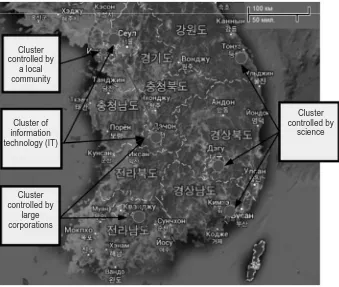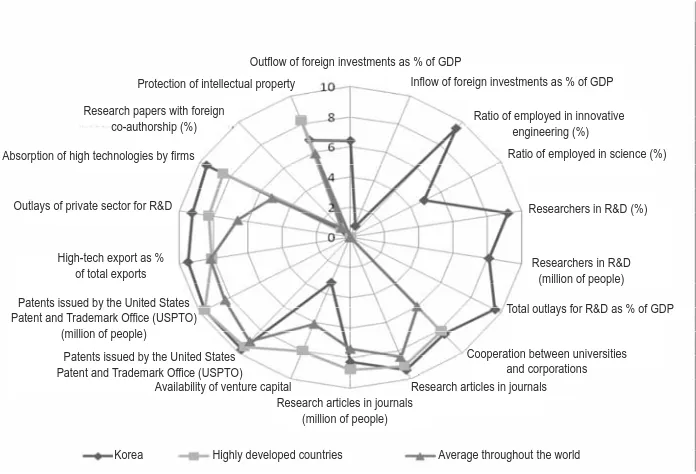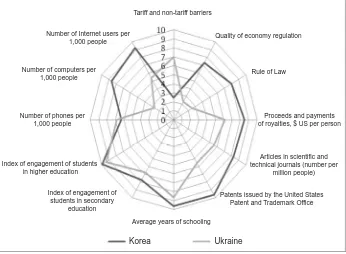Implementation of the knowledge
economy paradigm in the strategy
of national economy development
*DM Y T R O LU K I A N E N K O,
OL G A LU K I A N E N K O,
OL E X A N D R A DO R O S H E N K O1
ABSTRACT. This paper studies the knowledge economy paradigm and the factors of its influence on the development of national economies in the context of trans-formation of the global competitive environment. It has been methodologically identified the basic categories and concepts concerning the determination of key factors and parameters of modern economic systems. It has been proved through the example of South Korea that implementation of the knowledge economy para-digm in long-term strategies initiated and supported by the state provides new op-portunities of socio-economic progress. The basic problems of innovation-driven development of Ukraine’s economy through an assessment of its readiness to tran-sition to the knowledge economy, compared with South Korea. The latter’s experi-ence, despite the objective limitations, is regarded as an example of strategic suc-cess in formation of a creative innovation system.
KEYWORDS: globalization, post-industrial economy, knowledge economy, na-tional development strategy, innovation system, creative economy.
Introduction
Emergence of the global economy as the reality of 21st century led to change in the paradigm of economic development. In the intercon-nected and equally polarized world of the uneven distribution of re-sources and wealth, the search for new re-sources of economic develop-ment is an integral part of national policies and global modeling.
* This article was translated from its original in Ukrainian
1 DmytroLukianenko — Doctor of Economics, Professor, Head of the Chair of International Management, Director of Global Economic Policy Institute, First Vice-Rector for Scientific and Pedagogical and the Research Work of SHEE «Kyiv National Economic University named after Vadym Hetman». He has the title of Honored Master of Sciences and Engineering of Ukraine (2001) and two «Orders of Merit» of 3rd degree (2006) and 2nd degree (2012). The Chief Editor of journals «International Economic Policy» and «Securities of Ukraine». The author of over 200 scientific works. The main research areas are international economic integration, economic development globalization, international investment activity, global management. E-mail: lukianenko@kneu.kiev.ua
OlgaLukianenko — PhD in economics, an Associate Professor of International Management Chair of SHEE «Kyiv National Economic University named after Vadym Hetman». The main research areas are international organizations, innovative development, European integration. E-mail: kaf404-mm@mail.ru
OlexandraDoroshenko is a master of International Studies at Women's University «IXVA» (Seoul, South Korea), a Lecturer of International Management Chair of SHEE «Kyiv National Economic University named after Vadym Hetman». The key research areas are international organizations. E-mail: students-mm@mail.ru
IEP, № 19, (2013) pp. 5—25
Almost all countries, including economic leaders, face the prob-lem of ability to develop in the knowledge economy paradigm, while overcoming negative competitive impacts and adequately re-sponding to the challenges of global crisis. In the U.S. where unique conditions for the full functioning of reproductive science and technology cycles in almost all sectors and industries due to the concentration of the world's most productive intellectual re-source were created in 21st century, the problem of ensuring the innovation leadership and global competitiveness is continuously emerging full blown at the nationwide level. The EU experts also argue that the ensuring of well-established dynamics and competi-tiveness of the European economy would be made possible only in an environment where over the next few years a key priority of its development will be a so-called triangle of knowledge, i.e., crea-tion, transfer and use of knowledge through research, educacrea-tion, vocational training and innovation2. The knowledge- and
innova-tion-driven models of development at some point provided the competitiveness of «Asian tigers» – Japan, South Korea, Singa-pore, Taiwan, Hong Kong. The current strategies of Singapore («Intelligent Island»), South Korea («E-Korea»), China («Cap-ture of 21st Century with Knowledge») are ambitions revealing and largely set a pace of economic development of the modern world and become innovation modulators of the global economy by transforming their economies from commodity production to intel-lectual and creative persistently.
The potential belonging to the innovation values of the knowl-edge economy in their strategies and development programs is de-clared by India, Brazil, Russia, the Czech Republic, Hungary, the Baltic States. However, to do this, as stressed by Tuyen, it is necessary to reform the economic system itself3, which, in our
opinion, is extremely challenging and promising task for the above-mentioned countries. However, one cannot ignore the find-ings of Peter Drucker with regard to the thought that in the fu-ture there will not be any poor countries and will be only indiffer-ent4 when the underdevelopment will be determined by weak state
governance5.
2 Innovations in Ukraine: the European experience and recommendations for Ukraine. — Volume 3. Innovations in Ukraine: Proposals for political actions: final version (draft of 19.10.2011). — K.: Phoenix, 2011. — p.76 .
3 Tuyen, Thanh Nguyen. Knowledge Economy and Sustainable Economic Development: A Critical Review. — Walter de Gruyter GmbH & Co. KG, Berlin/ New York. — 2010 — [Electronic resource]. Access mode: http://www.e-cademic.de/data/ebooks/extracts/9783598251818.pdf
4 Drucker, Peter. The Age of Discontinuity: Guidelines to Our Changing Society. — New York: Harper & Row. — 1969. — Pp. 394.5
The purpose of the paper is to substantiate the importance of combination of the intellectually creative potential of a society and the world's scientific and technological achievements for the effec-tive implementation in the national economic development strategy of conceptual framework of the knowledge economy as a decisive factor for progress in the context of globalization. The South Ko-rean model of transition to the knowledge economy, the country's strategic achievements and challenges emerging full blown in the context of globalization are described in this study. The conclu-sions are, according to the authors, relevant to Ukraine, which, being at the beginning of its transformation towards the knowl-edge economy, faces difficulties with the development of a modern economic development strategy. The main idea is to understand the opportunities and limitations of use of the Korean model of eco-nomic growth in policies of other countries, and of Ukraine in the first place.
Methodological format of the study
The modern economic theory experiences the transformation of established categories and concepts, the generation of new meth-odological approaches. While developing on the basis of post-industrialism and having a certain logical sequence, they form the living tissue of modern terminology with the knowledge economy concept in the center (Figure 1).
The interpretation of knowledge as a separate essential element of economic activity is not comparatively new. Thus, in the early 20th century Joseph Schumpeter proposed the theory of «creative destruction» as a process of absolute transformation of the econ-omy due to a combination of expertise and innovative processes6.
Machlup first used the term «knowledge economy» in 1962 in his book «Production and Dissemination of Knowledge in the U.S.», where he referred to «knowledge» in the broad economic sense, noting that the allocation of resources in the areas of education and research activities is a major economic component, and the economy of education and the economy of research are the most dynamic new areas of economy specialization7.
In the context of evolution of competitive development sources, a plausible opinion is the one of Joseph Stiglitz with regard to that the knowledge and information are generated today just as easily as cars and steel were made hundreds of years ago, and such people as Bill Gates, knowing ways for production of knowledge and information, reap the fruits more effectively than others and become tycoons similarly to those who knew how to produce cars and steel a hundred of years ago8. He also stressed that knowledge
should be recognized not only as a social but also a global public good and thus has collective responsibility of the international community for the creation and dissemination of knowledge for the benefit of development9.
In other words, today competitive advantages are forming in the area of generation of knowledge, which in turn is reflected in innovations. Thus, the modern human capital includes not just the ability to collect and accumulate information but also the skills to transform it into knowledge that can be applied to practical solu-tion of strategic problems of economic development. Moreover, in the structure of economic relations in 21st century not just human capital, but the intellectual one which takes shape of intangible products and assets shall dominate. Thus, the transition from the industrial stage to the post-industrial information stage in the knowledge economy paradigm becomes point-blank.
According to the definition by the Organization for Economic Cooperation and Development (OECD), «The knowledge economy or the knowledge-based economy is the economy directly based on
6 Schumpeter, Joseph A. The Process of Creative Destruction. From Capitalism, Socialism and Democracy. — New York: Harper. — 1975 (Original publication 1942).
7 Machlup, Fritz. The Production and Distribution of Knowledge in the United States. — Princeton: Princeton University Press. — 1962. — Pp. 460.
8 Stiglitz, Joseph. Knowledge for Development: Economic Science, Economic Policy, and Economic Advice. — World Bank Conference on Development Economics. — Washington, D.C. — April 20–21. — 1998.9
the creation, distribution and use of knowledge and infor-mation»)10. Access to knowledge, innovationa, communicationa in
the modern conditions is not just an independent factor of devel-opment – it is decisive. The evaluation of phenomena of informa-tion, new and virtual economies is encouraged, which requires un-biased independent research, as in the depths of Internet not only «virtual economy» but also «virtual politics», «virtual diplomacy, «virtual culture», «virtual education» emerge. It becomes obvious that informglobalism dominant in almost all the global markets leads to operating by its participants not only virtual assets and li-abilities but also virtual knowledge in ever increasing amounts. Multimedia companies globally organized actually suppress through the influence of non-economic and non-coercive character immediately on people's mind the individuality and intellect, while ruthlessly exploiting them. The illusion of absence of limitations obvious for the traditional mind makes a human being more free with regard to realizing his potential, thereby increasing the social productivity. At the same time, the unprecedented online mass-media impact on the conscience made possible actually formalizes the most areas of life, imposes on the society the global pseudocul-ture standards. However, the realities of the information age stimulate the intellectual individualism, as the most creative part of the information values of civilization is not on physical media (hard disks, CD, web servers), but in the minds of people, their skills, talents, awareness and sensitivity to the creative self-development. In this context, the prospects of development are as-sociated with the transformation of the innovation economy into the intellectual and creative one.
In general, the prerequisites of modern economic methodology are formed in the study of globalization, which in its unprece-dented manifestation is a source and stimulant of competitive de-velopment and progress, being at the same time not linear and homogeneous, as its costs and benefits are unevenly, asynchro-nously and disproportionately distributed, especially in the cross-country terms.
The global economy which is emerging may be considered, on the one hand, as a subjectively, functionally and institutionally structured multilevel system which main integrating element is the global market. On the other hand, at present there is no question as to the universality and perfection of the system, but rather to: global availability of resources and innovations; global nature of factor mobility; global market unification and regulatory harmoni-zation; global individualization and corporatiharmoni-zation; regional and
continental consolidation; synchronization of rates and levels of economic development in a cyclic crisis presence; global socioliza-tion and politicizasocioliza-tion of economic relasocioliza-tions. In the structure of multi-mode and mixed global economy of early 21st century there are segments of pre-industrialism, industrialism and post-industrialism, enclaves of information, new, virtual, innovation, intellectual and creative economies.
In the situation where knowledge has become a key factor of economic growth and progress, economists have to explore new ways for most of their incorporation into innovative theories, mod-els and practices.
Experience of South Korea
Today, South Korea is one of the most successful examples of applying the knowledge economy paradigm to its development strategy. Forty years ago, its level of per capita income was almost the same as in Ghana, and in early 1990s, it exceeded the latter’s six times (Figure 2).
Fig. 2. Retrospective view of South Korea motion to the knowledge economy11
11 Based on a database of the World Bank and the World Bank's Development Program «Knowledge for Development (1998/99)». — [Electronic resource]. — Access mode:
A special role in reaching the knowledge economy and transfor-mation into the creative economy was played by the innovation system of South Korea, developed through the specialized public policy. It moved in its evolution from a model of catching up to the model of economic development, based on knowledge. When the government in 1980 first launched the National Research Pro-gram (NRP ) with focus on promoting R&D works, its main goal was to catch up with developing countries and to absorb foreign advanced technology. Projects of innovative development of the public and private sectors were largely focused on short-term tech-nological development due to absorbing or copying others' knowl-edge. The accumulation of financial resources and organizational experience in favorable external market conditions of early 1990s enabled the government of Korea to dramatically shift its innova-tion policy from simple copying of others' technologies to design-ing and manufacturdesign-ing of their major components along with the creation of infrastructure facilities for the development of knowl-edge-intensive industries in long-range outlook12.
It should be noted that the Government of Korea has always encouraged investment in scientific and technological development, but its role has changed qualitatively in the new innovative archi-tecture: the state has less directly interfered in the private sector efforts to stimulate individual creativity and entrepreneurial spirit. This was due to the process of appropriate institutionalization (Table 1).
Table 1. Institutional diversification of scientific and technological development of Korea13
Ministries Years Innovation program Managing institutions
Ministry of
Science and
Technology 1982 Special Research Program
Korean Institute of
Evaluation and
Planning of Science
and Technology
(KIEPST);Korea Science and Engi-neering Foundation Ministry of
Co-mmerce, Indu-stry and Ener-gy
1987-1988
Technical Program of Industrial Base Development; Program of Al-ternative Energy Development
Korean Institute of
Evaluation and
Planning of Science
and Technology
(KIEPST)
12 Dahlman, Carl and Thomas Andersson. Korea and the Knowledge-Based Economy: Making the Transition. — World Bank Publications // International Bank for Reconstruction and Development. — World Bank 2000. — Pp. 152
Ministries Years Innovation program Managing institutions
Ministry of In-formation and
Communications 1989
Program of Information and Commu-nication Technology Development (ICT)
Institute of Evalu-ation of InformEvalu-ation Technology (KIEIT)
Ministry of
Construction
and Transport 1994
Program of Building Technology Development
Korean Institute of Construction Tech-nology (KICT)
Transformation of Ministry of Science and Technology of Ministry of Education, Sci-ence and Tech-nology
2008
Main Research Projects; Special Projects of Basic Research Support; Project of Support and Promotion of Creative Research; Main Research Center of Scientific Medicine and Engineering
National Research
Center
Ministry of
Knowledge
Economy 2008
Creation of scientific and research network for acceleration of infor-mation commercialization and excha-nge; rationalization of research pro-cedures; cooperation with univer-sities, corporations and institutions that carry out research work; re-search outsourcing and involvement of major associations and academic groups in large scale R&D projects; strengthening of global cooperation through joint technological devel-opments, expanding of financial support to development and com-mercialization of technologies; in-crease in a level of creativity and ability for innovation of large corpo-rations, support to private invest-ment in R&D; encourageinvest-ment of in-dividual creativity and entrepre-neurial talent to meet the needs of the knowledge economy
Korean Institute of Technology Devel-opment (KITD)
Public (PRI) non-governmental
development of and
research institutions for
science and technology policy and basic research
Business sector and industrial clusters: research epicenter for
concentration of technology and
technological innovations
a
development of
Universities and higher education system –
provision of highly qualified technical education, accumulation
of knowledge and creative resources, performance of basic
research
National ability to innovate
Flow of knowledge, financial and human resources
Fig. 3. Concept of innovation system in Korea14
Table 2. Key indicators of the research activities of Korea in 1995—201015
1995 2000 2005 2008 2010
Gross domestic outlays for R&D
as % of GDP 2,3 2,3 2,79 2,9 3,74
Basic costs of research as % of
GDP 0,29 0,29 0,43 0,54 0,68
Number of researchers per 1000
persons of manpower 4,82 4,9 7,57 9,7 10,67
All R&D personnel per 1000
per-sons of manpower 7,3 6,24 7,52 12,09 13,55
R&D financed by production
sec-tor as % of GDP 1,76 1,66 2,09 2,45 2,68
R&D financed by the state as %
of GDP 0,44 0,55 0,64 0,85 1
Expenditure of business sector on
R&D as % of GDP 1,7 1,7 2,15 2,53 2,8
Expenditure of higher education
sector on R&D as % of GDP 0,19 0,26 0,28 0,37 0,4
14 Hemmert, Martin. The Korean Innovation System. From Industrial Catch-Up to Technological Leadership. — International Conference «Pathways to Innovation: Policies, Products, and Processes for Competitive Advantage in a Global Economy». — Nishogakusha University. — Tokyo. — May 20-21. — 200515
1995 2000 2005 2008 2010
% of R&D performed by business
sector 73,73 74,05 76,85 75,37 74,8
% of R & D performed by the
State 19,1 23,94 23,02 25,4 26,75
% of R&D performed by higher
education sector 8,7 11,28 9,93 11,4 10,28
% of R&D performed by private
sector 1,1 1,36 1,36 1,43 1,71
Programs of economic develop-ment as % of governdevelop-ment budget appropriations or outlays for R&D*
53,42 51,85 49,9 49,5
Environmental programs and
health programs as % of govern-ment budget appropriations or outlays for R&D
14,82 18,75 14,03 13,79
Number of patent applications
(total) 78 499 102 010 160 921 163 523 170 101
Number of patents registered
(to-tal) 12 512 34 956 73 512 83 523 68 843
Number of patents in ICT 43,05 890,81 2 300 3 120,58 3 700
Number of articles in scientific
and technical journals 3 308 9 572 16 396 18 600 21 350
*GBAORD = Government Budget Appropriations or Outlays for R&D
As it can be seen, the state's share in the financing of basic sci-ence and R&D is rather low because the leading role is played by the private business sector, mainly by Chaebol16. It is
demonstra-tive that a portion of the programs aimed at economic development and growth is over a half of all public spending on R&D, which confirms the priority for Korea of structural nationwide changes towards achieving the global competitiveness. In this case, univer-sities do not actively participate in the performance of major re-search, first of all, due to shortage of funds and lack of capabili-ties to conduct R&D, and, secondly, because of their traditional focus on education and human capital formation of the country for its universal ability to implement the knowledge economy.
Table 3 shows that R&D resources are concentrated mainly in the field of ICT and other knowledge-intensive industries, which confirms the sectoral orientation of Korea on creative activity in the modern paradigm of the knowledge economy.
Table 3.Internal R&D expenditures Korea by sectors (2004—2010)17
South Korea (million of US dollars)
Years
Socio-econo-mic objectives
2004 2005 2006 2007 2008 2009 2010
Research and exploitation
of the Earth 85.873 101.638 94.332 136.349 224.453 314.996 399.527
Environment 552.451 631.38 666.646 740.577 1054.806 1317.707 1321.824
Research and exploitation
of space 319.839 310.22 412.089 381.919 437.709 360.413 356.476
Transport, telecommu-nications and ICT infrastr-ucture deve-lopment
417.426 325.861 305.543 551.036 2105.949 2571.59 4304.386
Energy 895.025 937.483 1180.351 1526.421 2002.527 2487.739 3195.112
Industrial production and innova-tion techn-ologies
—19370.522 23039.34 23493.074 25937.656 29883.857 28954.231 30054.877
Agriculture 721.296 687.225 783.194 964.963 1112.792 1163.84 1208.287
Education .. .. .. .. 268.125 399.775 444.514
Culture, reli-gion and mass media
.. .. .. .. 472.86 682.928 807.479
Political and social syst-ems, processes and structu-res
.. .. .. .. 460.955 606.852 597.212
General de-velopment of the knowled-ge economy
1407.881 1702.12 2553.756 2166.709 821.499 1287.562 1393.439
Defense 932.718 713.175 789.817 936.06 1234.309 1861.86 2009.959
Total 28305.225 30618.326 34711.976 38923.471 41685.335 44311.219 49447.725
A response of South Korea adequate to modern challenges to the extremely difficult problem of industrialization and appropri-ate infrastructure provision for economically backward regions of the country through the creation of industrial clusters is required, in our opinion, special research attention. In the process of their building a synergistic effect was achieved by regional concentra-tion of different sector companies due to the minimizaconcentra-tion of
17 Based on the database of OECD (Principal scientific and technological indicators. [Electronic resource]. Access:
duction and transportation costs, generation of benefits of econo-mies of scale, increase in employment level, increase in foreign in-vestment, etc. Afterwards the formation of a favorable environ-ment for innovation spurred the transformation of industrial clusters in innovation technoparks based on the knowledge economy, which are developing towards the creative economy (Figure 4).
Cluster controlled by
a local community
Cluster of information technology (IT)
Cluster controlled by
large corporations
Cluster controlled by
science
Fig. 4. Location of clusters in Korea18
In general, the Korean economy in the effective symbiosis of na-tional and business motivations and concerted actions has trans-formed in the innovative and creative knowledge economy, be-coming a highly competitive member of the global market. However, such level of competitiveness, in our opinion, can be de-termined only in a system of international comparative matches. In the context of our study, experts from the World Bank have con-cluded that the successful transition to the knowledge economy volves the creation of certain conditions through long-term
vestments in education, development of innovation systems, con-tinuous upgrading of information infrastructure and formation of an enabling environment for market innovation19. The ability of
countries to form the knowledge economy is evaluated in the for-mat of appropriate criteria (Table 4).
Тable 4. The level of readiness of countries for transition to the knowledge economy among 146 countries of the world (from 0 to 10 points) according
to the methodology of the World Bank
Components
Position
in 2012 Country
Edu
cation
Innovation
sy
s-te
m
Information
and
communication technolog
ies
Index
of
knowl-edg
e
Economic
in-centives
and
in-stitutional
re-gime Knowledge economy
index
1 Sweden 8.92 9.74 9.49 9.38 9.58 9.43
2 Finland 8.77 9.66 9.22 9.22 9.65 9.33
3 Denmark 8.63 9.49 8.88 9 9.63 9.16
4 Netherlands 8.75 9.46 9.45 9.22 8.79 9.11
5 Norway 9.43 9.01 8.53 8.99 9.47 9.11
8 Germany 8.2 9.11 9.17 8.83 9.1 8.9
29 South Korea 9.09 8.8 8.05 8.65 5.93 7.97
55 The RussianFederation 6.79 6.93 7.16 6.96 2.23 5.78
56 Ukraine 8.26 5.76 4.96 6.33 3.95 5.73
Source: The Knowledge Assessment Methodology of the World Bank (www.world-bank.org/kam)
The positions of South Korea in education are impressive with rather significant indicators relating to development of the na-tional innovation system and information and communication technologies. Despite considerable influence of the state on sup-porting the innovations, the institutional regime is estimated as negligible compared to the leading countries in rating (Figure 5).
In general, South Korea even exceeds by many indicators the highly developed countries and the world's average values. It is a leader as to the number of employed in the areas of science and technology, outlays for R&D, including those of private sector, the manufacturing of mobile phones, semiconductor memory chips,
automobiles, shipbuilding, telecommunications, high-tech export, which is provided by the well functioning innovation system with targeted support of the state.
Outflow of foreign investments as % of GDP
Protection of intellectual property Inflow of foreign investments as % of GDP Research with foreign
co-authorship (%)papers Ratio employed in innovativeof engineering (%)
Absorption of high technologies by firms Ratio employed in science (%)of
Outlays of private sector f R&Dor Researchers in R&D (%)
High-tech export as %
of total exports Researchers in R&D (million of people)
Patents issued by the United States Patent and Trademark Office (USPTO)
(million of people)
Total outlays for R&D as % of GDP
Patents issued by the United States Patent and Trademark Office (USPTO)
Cooperation between universities and corporations Availability of venture capital Research articles in journals
Research articles in journals (million of people)
Korea Highly developed countries Average throughout the world
Fig. 5. Indicators of the Innovation system: a comparative analysis20
However, to become a sustainable social harmonized society of the knowledge economy, it is required the continuous generation and implementation of highly ambitious national development strategies, which today is the state program «Future of 2025: Ko-rea's long-term plan for the development of science and technol-ogy», that will facilitate its positioning as an example of 21st cen-tury economy, as one of the global centers of creative knowledge economy.
Lessons for Ukraine
Globalization causes the ever increasing impact on the economic development of Ukraine as external challenges under conditions of high openness of the national economy are becoming more notice-able. This also applies to the traditional raw material oriented and energy-intensive industries, which experience the severe impact of global price situation and especially to innovative segments of the
economy, that are directly dependent on orientation of the state and business on the generation and commercialization of knowl-edge.
Aggravation of the global competition pushes major corporate market actors to find the most optimal new forms of production and sale of new goods and services, and the states to create effec-tive national innovation systems. At the same time, the global experience, particularly in South Korea, shows that not only reaching and holding the position of a global innovation leader is an extremely difficult task, but also a task of catching up with the leaders in the most profitable science-intensive segments of market.
As far as Ukraine is concerned, the availability of highly qualified staff and national education, including the higher edu-cation, received due recognition in the above rating of readiness of the country to the knowledge economy (Table 4). According to UNESCO, Ukraine is among the world leaders in terms of a pro-portion of the population aged 25 years with higher education (indicator of higher education prevalence is 38 %) with the high-est index at the European level only in Russia (54.8 %), and globally in the United States (38.6%), Israel (42.4% ) and Can-ada (43.9 %)21. Ukraine occupies in the rating of countries in
terms of global competitiveness in 2012-2013 47th position among 144 countries by sub-index «Higher Education and Training» (Russia – 52)22. The global network of research universities
«Universitas 21», while evaluating the state policy as to educa-tion, its effectiveness, resource provision, awarded the Ukrainian higher education system with the 25th position among 48 coun-tries. Ukraine managed to get ahead of the Czech Republic, Po-land, Slovenia, Russia and Italy. The education systems of the United States, Sweden, Canada, Finland and Denmark were rec-ognized as the best.
This situation is also confirmed by other international ratings. Thus, according to some values of the global innovation index, in 2010-2011 Ukraine ranked pretty high places: innovation potential – 11; availability of higher education – 14; net inflow of direct for-eign investment – 29; public spending on R&D – 31; ability to innovate – 32; human capital – 36. Instead, effectiveness of the legal system is positioned as 129, regulatory environment – 112, protection of intellectual property – 107, an index of investor
21 Global Education Digest 2011. Comparing Education Statistics across the World // UNESCO Institute for Statistics. — Montreal, 2011. — 312 р. — [Electronic resource]. — Access mode: http://www.uis.unesco.org/Library/Documents/global_education_digest_2011_en.pdf
22 The Global Competitiveness Report 2012-2013 // World Economic Forum, 2013. — 545 р. — [Electronic resource]. — Access mode:
protection – 12923. In fact, the country follows the path of
copy-ing substantially all modern technologies, while preservcopy-ing human, natural and financial resources for domestic technologies of lower industrial structures.
However, the natural resources available continue to be ex-ploited today in Ukraine, when export-oriented business repre-sented by large corporations of raw mineral complex is based on low-tech production providing a certain level of employment and preservation of its monopoly position of leadership in the national economy. Global ratings for 2007-2011 reflect the deterioration of most indicators of competitiveness of Ukraine. It is indicative that while its place by the general global competitiveness index fell by 10 points (from 72nd position among 134 countries in 2007-2088 to 82 among 142 countries in 2011-2012), fall by the criterion of in-novation was 22 points, technological readiness – 17, spending by companies on R&D – 23, cooperation between universities and businesses in research activities – 21.
The main reasons that hinder the effective implementation of innovation and technological model of the Ukrainian economy de-velopment include: immaturity of the national innovation system; a low level of financing the innovation sector; low innovation ac-tivity of domestic enterprises and weak links between actors in the innovation sector, a low level of research works in the business sector; a low level of innovation commercialization; a scanty de-mand for innovative products by the industrial sector; weak scien-tific and technological exchange; an extremely low level of pat-enting of domestic inventions with foreign patent organizations; a lack of national venture capital market and competition in the in-novation entrepreneurship; underdevelopment of the legal frame-work governing the innovation sector. This is followed by a rapid decline in the quality of education, research degradation of both retrospectively productive institutes of the National Academy of Sciences of Ukraine and leading domestic universities. Instead, the advanced forms of intellectual capital concentration and intensifi-cation of innovation activities well proven in the world, such as clusters, technoparks, technopolises, are scarcely used in Ukraine.
The experience of South Korea shows that the most common form among large-scale industrialization forms and subsequently the local concentration of innovations became just clusters that of-fered new opportunities for the development of both traditional sectors of economy and the newest ones. Experts rightly assert that the cluster structures are, first of all, innovative, act as an engine of growth of national and regional economies and that the
mentation of cluster initiatives is a key tool for competitiveness of countries.
Although, in principle, we can talk about a minimum regu-latory support of organization of progressive forms of innovative development in the economy of Ukraine (Law of Ukraine «On In-novation», Law of Ukraine «On Special Regime of Innovation Ac-tivity of Technology Parks», the Resolution of the Cabinet of Ministers of Ukraine «On Approval of Regulation on Procedure for Establishment and Operation of Technoparks and Other Types of Innovative Structures», the Resolution of the Cabinet of Minis-ters of Ukraine «On Approval of Concept of National Innovation System Development» and other regulatory legal acts of Ukraine), their occurrence is not only fragmented but statistically inconsis-tent24. Moreover, it never comes to the organization and operation
of innovation clusters in the official programs and national statis-tics, although, given the experience of South Korea, in particular, it could be argued that it was clusters of this type that appeared to be the most effective during the evolution of forms of concen-tration of innovation activities to enhance the competitiveness of regions.
However, the formation of motivation and practical actions to transit to the knowledge economy most naturally occurs in the countries where not only technological, but also micro- and macro-economic conditions have been established.
A visual representation of comparing the baseline indicators of the knowledge economy in Korea and Ukraine (Figure 6) shows some lag in our country, but in the sectors of education and hu-man resources, Ukraine and Korea are almost at the same level. This means that Ukraine may create favorable conditions for inno-vation development of the economy, based on the significant past investment in education and science, where significant competitive advantages still exist.
In the case of South Korea, for example, the indicator of tariff and non-tariff barriers shows a low level of economic freedom in the country, and as far as Ukraine is concerned, ICT indicators are the most critical, which, in our opinion, largely resulted in a gen-eral lag in transition to the knowledge economy.
The importance and primary role of the knowledge economy in the transformation processes of 21st century are inarguable in theoretical and practical terms, when pioneering technological and organizational ideas have become a major driving force for eco-nomic progress. Today the most popular products in the global
market becomes the intellectual property, especially in the sector of information and communication technologies.
Tariff and non-tariff barriers
Number of Internet users per 1,000 people
Number per
1,000 peopleof computers
Quality of economy regulation
Rule of Law
Number of phones per
1,000 people of royalties, $ US Proceeds and payments per person
Index of students
in higher educationengagement of
Articles in scientific journals (number per million people)
and technical
Index of
students in secondary education
engagement of Patents issued by the
Office United States Patent and Trademark
Average years of schooling
Korea Ukraine
Fig 6. Baseline indicators of Ukraine and Korea within the criteria for the knowledge economy, 2005–201125
Conclusions
Transition from the raw material production economy of indus-trial type to the post-indusindus-trial information knowledge economy requires implementation of its values in national economy devel-opment strategies. Despite the fairly loyal and somehow harmo-nized international rating estimates, a huge gap between developed and other countries as to mastering the results of techno and in-formative globalization has long been fixed quite a while. The catastrophic lag behind the world's scientific and technological progress with no apparent prospects of catching up development has been emphasized in the Development Program of the World Bank's titled «Knowledge for Development» in relation to devel-oping countries, structured in accordance with the modern priori-ties of the knowledge economy26.
25 Based on the knowledge evaluation methodology of the World Bank (www.worldbank.org/kam)26
The example of South Korea is one of the most successful pat-terns of application of the knowledge economy paradigm with the practical demonstration of a positive correlation between an inno-vation development strategy and economy growth. It became an example of successful combination of the interests and efforts of the state and business with regard to the consolidated innovative development providing a high competitive status of the country in the global economy.
Despite the innovative development priorities of Ukraine's economy repeatedly declared at all levels, it has not been man-aged so far to create in it a competitive environment and inno-vative climate, to significantly increase the innovation motiva-tion of economic entities, to optimally use the limited financial resources for research and technological modernization. This situation not only discredits the existing national innovation ca-pacity, but is unacceptable for the country with pretensions to formation of the knowledge economy that is increasingly as-suming the characteristics of creativity in its progressing seg-ments.
The formation of an effective innovation system and implemen-tation of the cluster approach, providing effective tools and in-struments to stimulate the effective development, concentration of financial resources is vital for the national economy, which has great potential of modernization of traditional technologies and development of new ones. In the context of national competitive-ness in the global development environment, Ukraine requires, on the one hand, the synthesis and use of adequate experience on im-plementation of its modern cluster policy, and, on the other hand, keeping to the systemic innovation policy with the goals, motiva-tions and priorities of economy clustering, defined at the state level.
References
1. Dahlman, Carl and Thomas Andersson. Korea and the Knowledge-Based Economy: Making the Transition. – World Bank Publications // International Bank for Reconstruction and Development. – World Bank 2000. – Pp. 152
2. Drucker, Peter. The Age of Discontinuity: Guidelines to Our Changing Society. – New York: Harper & Row. – 1969. – Pp. 394.
3. Global Education Digest 2011. Comparing Education Statistics
across the World // UNESCO Institute for Statistics. – Montreal,
2011. – 312 р. – [Electronic resource]. – Access mode: http://
www.uis.unesco.org/Library/Documents/global_education_di gest_2011_en.pdf
4. Global Innovation Index 2009/10/ – [Electronic resource]. –
Access mode: http://www.globalinnovationindex.org.
5. Hemmert, Martin. The Korean Innovation System. From Indus-trial Catch-Up to Technological Leadership. – International Conference «Pathways to Innovation: Policies, Products, and Processes for Competi-tive Advantage in a Global Economy». – Nishogakusha University. – Tokyo. – May 20-21. – 2005
6. Innovations in Ukraine: the European experience and recommendations
for Ukraine. – Volume 3. Innovations in Ukraine: Proposals for political actions: final version (draft of 19.10.2011). – K.: Phoenix,
2011. – p.76. [in Ukrainian]
7. Knowledge Assessment Methodology of the World Bank
[Elec-tronic resource]. – Access mode: http://info.worldbank.org/etools/ kam2/KAM_page1.asp
8. Knowledge evaluation methodology of the World Bank [Electronic
resource]. Access mode: www.worldbank.org/kam
9. Lukianenko O.D. Clusters in the system of innovation activity
in-tensification/O.D. Lukianenko// Problems and prospects of
development of cooperation between the countries of South-Eastern Europe in the framework of the Black Sea Economic Cooperation and GUAM. Collection of scientific papers – Albena-Donetsk: DonNU, RF
NISS in Donetsk, 2012. – pp. 185-188. [in Ukrainian]
10. Machlup, Fritz. The Production and Distribution of Knowledge in the United States. – Princeton: Princeton University Press. – 1962. – Pp. 460.
11. Ministry of Education, Science and Technology of South Korea
data. [Electronic resource]. – Access mode: http://www.moe.go.kr/ main.do
12. Ministry of Knowledge Economy of South Korea data.
[Elec-tronic resource]. – Access mode: http://www.mke.go.kr/language/ eng/index.jsp
13. OECD database (Main scientific and technological indicators).
[Electronic resource]. Access mode: http://stats.oecd.org/Index.aspx? DataSetCode=MSTI_PUB.
14. OECD database (Principal scientific and technological indicators.
15. Organization for Economic Cooperation and Development. The Knowledge-Based Economy. – OECD/GD (96)102. – Paris. – 1996.
16. Organization for Economic Cooperation and Development. The
Knowledge-Based Economy. – OECD/GD (96)102. – Paris. – 1996. 17. Peter F. Drucker. Management. Challenges of 21st century:
Transl. from English. – М.: publishing house Mann, Ivanov and Ferber,
2012. – 256 p. [in Russian]
18. Schumpeter, Joseph A. The Process of Creative Destruction. From Capitalism, Socialism and Democracy. – New York: Harper. – 1975 (Original publication 1942).
19. Stiglitz, Joseph. Knowledge for Development: Economic Science, Economic Policy, and Economic Advice. – World Bank Conference on Development Economics. – Washington, D.C. – April 20—21. – 1998.
20. The Global Competitiveness Report 2012-2013 // World
Eco-nomic Forum, 2013. – 545 р. – [Electronic resource]. – Access mode:
http://www3.weforum.org/docs/WEF_GlobalCompetitiveness Report_2012-13.pdf
21. The World Bank. WDR [World Bank Development Report].
Knowledge for Development. World Bank and Oxford University Press,
1998. – Pp. 181.
22. The World Bank's Development Program «Knowledge for
Devel-opment (1998/99)». – [Electronic resource]. – Access mode: http://go.worldbank.org/AW9KZWJB10
23. Tuyen, Thanh Nguyen. Knowledge Economy and Sustainable Economic Development: A Critical Review. – Walter de Gruyter GmbH & Co. KG, Berlin/ New York. – 2010 – [Electronic resource]. Access mode:
http://www.e-cademic.de/data/ebooks/extracts/9783598251818.pdf
24. WBI. [The World Bank Institute Development Studies].
Build-ing Knowledge Economies. Advanced Strategies for Development. Washington, DC: The International Bank for Reconstruction and Devel-opment, 2007 – p. 4.
